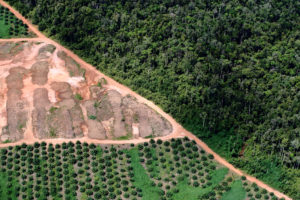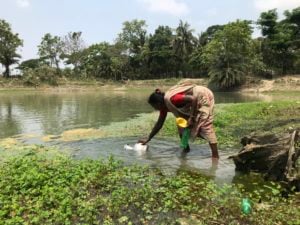The protection, restoration and sustainable management of forests are crucial both for achieving China’s climate targets, and for conserving biodiversity.
Halting deforestation has been on the international agenda for some time. The New York Declaration on Forests (NYDF), announced at the 2014 UN climate summit, brought together companies, governments, civil society organisations and communities, with the aim of halving natural forest loss by 2020, and ending it by 2030.
12,000,000
hectares of tropical forest were lost in 2020
But a 2020 NYDF progress report showed that deforestation had only worsened since 2014. The latest figures from Global Forest Watch show that 4.2 million hectares of humid tropical primary forests – an area the size of the Netherlands – were lost in 2020 alone. In total, the tropics lost 12 million hectares of tree cover in that year. One of the goals of the NYDF was to end deforestation from agricultural commodities such as palm oil, soy and timber by 2020. Clearly, that goal has not been achieved.
Indonesia is the world’s largest producer of palm oil. In that country alone 270,000 hectares of primary forest were lost in 2020, with the expansion of oil palm plantations a key cause. Palm oil is a major driver of deforestation. Unsustainable palm oil production causes other environmental harms, including forest fires, biodiversity loss and greenhouse gas emissions.
China is the world’s second largest importer of palm oil and is heavily reliant on Malaysia and Indonesia for those imports. In 2020, China imported 7.2 million tonnes of palm oil, with only a single-figure percentage of that being certified as sustainable. The Chinese government has no dedicated rules on environmental and social sustainability for palm oil imports, and market demand for sustainable palm oil remains low.
A new report on Chinese financing of the palm oil value chain by CDP, a non-profit working on environmental information transparency, found potential deforestation risks, which in turn creates risks for the financial institutions supporting these chains.
Our research sampled 31 firms in China’s palm oil value chain, most of which were trading or downstream consumer firms. These included the largest palm oil importers, as well as manufacturers of food products and of personal care products and detergents, and food services and restaurants. The researchers analysed the flows of finance through the palm oil supply chain, identified the financial institutions funding them and calculated how much of their money is exposed to deforestation risks.
Between 2013 and 2020, the 31 companies attracted US$28.7 billion of loans and underwriting services linked to palm oil in China. Of that, $5.1 billion (or 18%) was provided by 75 Chinese lenders, including the big four state-owned banks. About a third (36%) of that $5.1 billion went to producers of edible oils. Another third (33%) went to palm oil trading firms. The dairy industry came next (24%).
Besides, as of January 2021, 115 Chinese institutional investors (including asset managers and insurance companies) held or were underwriting shares in Chinese palm oil supply chain companies worth US$500 million.
The production and use of palm oil attached to environmental and social risks in turn create risks for their lenders and investors. These risks come from increasingly tough oversight by both producer and consumer nations, increasing demand from consumers for sustainable palm oil, and physical risks arising from climate change. Ultimately, these risks will materialise in the form of bad loans, falls in the value of collateral, and reduced profitability and ability to repay loans.
The research found that, overall, Chinese financial institutions have varying levels of awareness of the environmental and social risks associated with palm oil, but in all cases have done little in response. Based on public data, none of the identified financial institutions in the palm oil sector identified in the report have disclosed the exposure of their portfolio to forest-risk commodities in the reporting year; none have recognised the operational risks arising from forest-risk commodities, none include forest risk in their decision-making processes; and none have put a sectoral or deforestation policy in place.
Chinese banks, when compared with other financial institutions in the country, are more environmentally aware and have environmental, social and governance (ESG) risk frameworks in place in order to meet environmental and regulatory compliance demands. However, deforestation has not yet been explicitly included in those frameworks.
There are international examples to follow when integrating forest and sustainability concerns into palm oil sector business models and strategy and investment decisions. In 2002, HSBC published its first sustainability risk policies, designed to ensure that the financial services it provides do not have unacceptable consequences for people or the environment.
Then in 2004 the bank, one of the founders of the Roundtable on Sustainable Palm Oil (RSPO), published a sustainability policy for forestry and agricultural products, which applies to the palm oil sector. HSBC’s palm oil policy required its clients to become RSPO members and, by 2018, to have all their facilities 100% RSPO certified. Clients also had to make a “No Deforestation, No Peat, and No Exploitation” (NDPE) commitment and receive a third-party due diligence investigation.
As the world’s largest importer and consumer of soft commodities, China needs to urgently tackle deforestation issues in its supply chains
Many institutional investors have set up detailed sustainability policies to reduce deforestation risks in their portfolio. In 2019, the UN’s Principles for Responsible Investment (PRI) Investor Working Group on Sustainable Palm Oil published a statement putting forward what was expected of palm oil firms, and stressed investors’ support for sustainable palm oil. It also encouraged firms to become RSPO members, adopt an NDPE policy, set time-bound plans, and report regularly on progress and practice.
Robeco, an asset management firm, PRI member and signatory to that document, has gone further, by focusing on investing in firms, which have 80% or more of their palm oil production certified as sustainable.
China’s carbon reduction targets have made the country’s financial institutions more aware of their exposure to climate risks. But knowledge of deforestation risks remains inadequate. As the world’s largest importer and consumer of soft commodities (agricultural, forest, fish and livestock products), China needs to urgently tackle deforestation issues in its supply chains. Financial institutions will be crucial to this process.
In April, the People’s Bank of China, the National Development and Reform Commission and the China Securities Regulatory Commission, published an update to the types of projects eligible for green financing support. The trading of green agricultural commodities was listed, in particular when certified sustainable by international certification schemes. This aligns with global goals on forest protection. However, Chinese companies and financial institutions have yet to respond to that policy signal, and the palm oil trade reflects how awareness of forest risks is lagging behind.
To change this state of affairs, financial institutions should first identify and assess the deforestation risks associated with their lending and investment in the commodities value chain, and the impact of those risks on climate change and biodiversity loss. Next, they should adopt best practices from other firms, determine forest-risk policies, and integrate those into their green finance and ESG risk-management processes. Third, they should encourage their clients to do the same and use global standardised reporting frameworks to increase transparency.
Our research also found that although awareness of forest risks among Chinese financial institutions remains low, they are highly aware of “regulatory risks”, which means their actions on the environment are primarily driven by regulation. So, China’s policymakers should categorise sustainable soft commodities, produce associated standards, and include deforestation risks in transparency requirements for financial institutions and companies.
Crucial UN meetings on climate change – COP26 – and biodiversity – COP15 – are soon to be held. These will offer an opportunity for China’s policymakers to demonstrate, on a global stage, their ambitions on curbing climate change and conserving biodiversity. A key part of that will be strengthening international partnerships with producer nations and promoting zero-deforestation supply chains.









